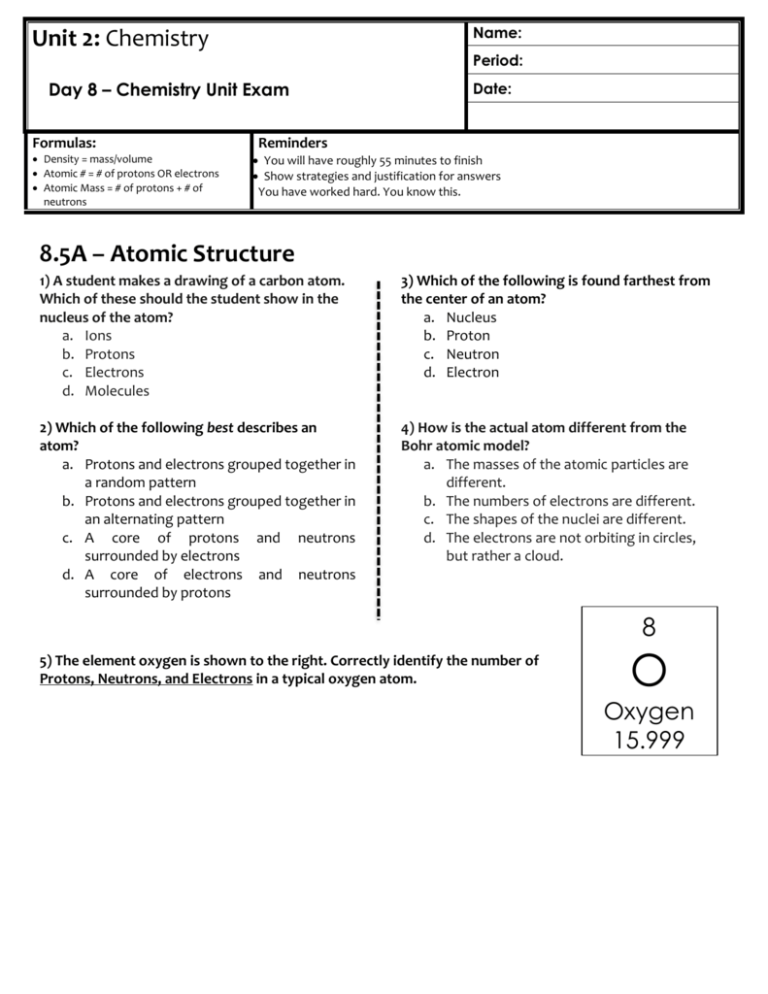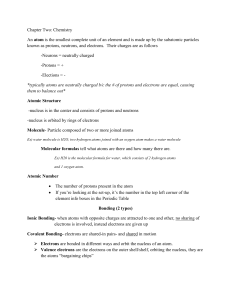Unit 2
advertisement

Name: Unit 2: Chemistry Period: Day 8 – Chemistry Unit Exam Formulas: Density = mass/volume Atomic # = # of protons OR electrons Atomic Mass = # of protons + # of neutrons Date: Reminders You will have roughly 55 minutes to finish Show strategies and justification for answers You have worked hard. You know this. 8.5A – Atomic Structure 1) A student makes a drawing of a carbon atom. Which of these should the student show in the nucleus of the atom? a. Ions b. Protons c. Electrons d. Molecules 3) Which of the following is found farthest from the center of an atom? a. Nucleus b. Proton c. Neutron d. Electron 2) Which of the following best describes an atom? a. Protons and electrons grouped together in a random pattern b. Protons and electrons grouped together in an alternating pattern c. A core of protons and neutrons surrounded by electrons d. A core of electrons and neutrons surrounded by protons 4) How is the actual atom different from the Bohr atomic model? a. The masses of the atomic particles are different. b. The numbers of electrons are different. c. The shapes of the nuclei are different. d. The electrons are not orbiting in circles, but rather a cloud. 8 5) The element oxygen is shown to the right. Correctly identify the number of Protons, Neutrons, and Electrons in a typical oxygen atom. O Oxygen 15.999 8.5B – Identity + Reactivity 6) The diagram to the right represents a Bohr Model of an element. Using the periodic table, as well as your knowledge of atoms, what is the name of this element? a. b. c. d. Argon Neon Chlorine Fluorine 7) Using the diagram to the left, how many valence electrons does the atom have? a. b. c. d. 2 3 4 5 9) What is the number of electrons in a completely filled second shell of an atom? a. b. c. d. 32 18 8 2 8) The diagram above displays the Alkali Metals (Group 1) from the Periodic Table. These metals are so reactive that they can even catch fire in water. Why are Alkali Metals so reactive? a. b. c. d. They want to lose their one valence electron They want to gain 7 more electrons They have a full outer shell They want to lose their two valence electrons 10) Chlorine has 7 valence electrons in its outer shell. Because of this, chlorine’s reactivity would be best described as ___________________. a. b. c. d. Very reactive Somewhat reactive Nonreactive Neutral 8.5C – Periodic Table 11) Identify one element that has chemical properties similar to the chemical properties of fluorine. Write your answer in the box for #11 on your answer sheet. 12) Which of the following elements has properties most similar to Gold (Au)? a. b. c. d. Zinc (Zn) Mercury (Hg) Silver (Ag) Cadmium (Cd) 13) Danny is completing a research project for Mr. Goel’s class on the Periodic Table. He makes the following list of characteristics about the elements in the group to the right: In group #17 # of Valence Electrons = 7 Often used in cleaning and sanitation products Which of the following choices would best represent the reactivity of the elements in this family? a. Reactive b. Highly reactive c. Somewhat reactive d. Nonreactive 14) What is true about elements P, Q, R, and S? a. They are in the same period b. They are in the same group c. They are all nonmetals d. They are all gases 15) Group #18 on the periodic table consists of elements that are non-reactive, meaning that they do not bond or create chemical reactions with any other elements. Which family name is attributed to Group #18? a. b. c. d. Alkali Metals Alkaline Earth Metals Halogens Noble Gases 6.6A – Metals, Nonmetals, Metalloids 16) Which of the following elements would be considered a metalloid? a. b. c. d. Zinc Iron Sulfur Carbon 17) What is a common physical property of Fe, Co, Ni, Cu, and Zn? a. b. c. d. They are all malleable They are poor conductors They react easily with gases They are brittle 18) What do the elements sulfur (S), nitrogen (N), phosphorus (P), and bromine (Br) have in common? a. b. c. d. They are noble (inert) gases They are nonmetals They have the same thermal conductivity They have the same number of protons 19) The diagram shows a simplified periodic table. Each of the number blocks represents an element. Which element easily conducts electricity and can be bent or hammered into a new shape (malleable)? a) Element 1 b) Element 2 c) Element 3 d) Element 4 8.5D – Chemical Formulas 20) The diagram below shows the arrangement of atoms and the chemical composition of a water molecule. The table shows common elements and their chemical symbols. What two elements make up the water molecule? Write your answer in box #20 on your answer sheet. Use the following chemical formula for Glucose in questions 21 and 22 C6H12O6 21) How many elements are in a molecule of glucose? a. b. c. d. 22) How many atoms are in a molecule of glucose? a. b. c. d. 3 4 24 26 3 4 24 26 23) How do you determine the number of silicon atoms in the formula below? 4SiO2 a. b. c. d. # of Si atoms # of Si atoms # of Si atoms # of Si atoms = = = = coefficient 4 coefficient 4 subscript 4 coefficient 1 + X X + subscript 1 subscript 1 coefficient 2 subscript 1 = = = = 5 4 6 2 7.6A + 6.5C – Organic Compounds + Elements vs. Compounds 24) Carbon dioxide (CO2) is not found on the Periodic Table of the Elements because carbon dioxide is a. b. c. d. An atom A gas A mixture A compound 25) Which of the following compounds would be considered organic? a. b. c. d. C6H12O6 CO2 H2O NH4 The table below shows the number of each kind of atom that makes up one molecule of the compounds sucrose and ethanol. 26) Which of the following is the same for both compounds? a. The mass of each molecule b. The length of each molecule c. The types of atoms of elements in each molecule d. The number of atoms of elements in each molecule 27) Which of the following is the best example of compounds of only one kind? a. c. b. d. 28) Some common substances and their chemical formulas are listed in the chart to the right. Which of these substances are elements? a. hydrochloric acid and carbonic acid b. carbon dioxide and water c. oxygen and helium d. water and oxygen 8.5E – Chemical Changes 29) The diagram to the right shows what happens when crushed limestone (like chalk) is placed in acid. List one observation that shows a chemical change is occurring in the diagram. Write your answer in box #31 on your answer document. 30) Which action forms a different chemical substance? a. b. c. d. crushing a rock burning a piece of wood mixing salt and pepper melting an ice cube 31) Hydrochloric acid is added to a beaker containing a piece of zinc. As a result, zinc chloride is formed and hydrogen gas is released. This is an example of a. a chemical reaction b. a physical change c. photosynthesis d. evaporation (4) on the bottom of the beaker 27 The four diagrams below model the results of mixing atoms of different substances. Each atom is represented by a different symbol. 32) The diagram to the right shows an activity performed byWhich diagram correctly models a chemical a student. What kind of change would this best represent? change? a. Chemical change, because gas is released b. Chemical change, because a new substance is created ) c. Physical change, because the melting ice indicates a (1 phase change d. Physical change, because there is a temperature increase + + (2 ) different substances. Each atom is 33) The four diagrams below model the results of mixing atoms of represented by a different symbol. Which diagram correctly models a chemical change? a. c. (3 ) b. + d. (4 ) + I nter.-Level Science — June ’01 8.5F – Law of Conservation of Matter 34) Which of the following is the best description of the Law of Conservation of Matter? a. Matter cannot be created or destroyed, only transformed b. Matter can be created and destroyed, not transformed c. Matter can be created, but not destroyed or transformed d. Matter cannot be created, but can be destroyed and transformed 35) Which chemical equation is balanced to show that mass is conserved during the reaction? a. 2Na + Cl2 → 4NaCl c. CH4 + 2O2 → CO2 + 2H2O b. 2H2O2 → 4H2O + O2 d. AgNO3 + MgCl2 → 2AgCl + MgNO3 [8] The following equation shows photosynthesis in plants. 6CO2 + 6H2O C6H12O6 + 6CO2 36) Is the equation seen above balanced? Circle YES or NO on your answer sheet in question #36. 37) The chemical equation listed in the table below describes what happens when you mix aluminum oxide (2Al2O3) and carbon (3C) together. 2Al2O3 + 3C 4Al + 3CO2 Beginning mass of Reactants 150 g Mass of 4Al (in Product) 135 g Mass of 3CO2 (in Product) ?g How many grams of Carbon dioxide gas (CO2) should have been released, according to the law of conservation of mass? Write the answer in #37 of your answer sheet. Balance the following equations – Write the coefficients in the answer grid. Name: Period: Date: Answer Grid – Record your answers in the space provided below: 1 2 3 4 5 6 7 8 9 10 11 12 13 14 15 16 17 18 19 20 21 22 23 24 25 26 27 28 29 30 31 32 33 34 35 36 37 38 39 40 41 42 43 44 45






